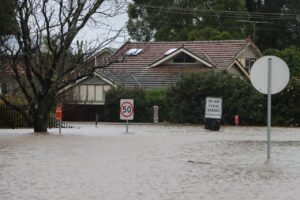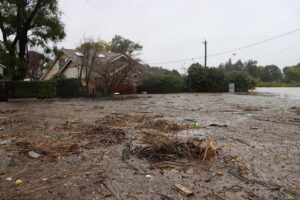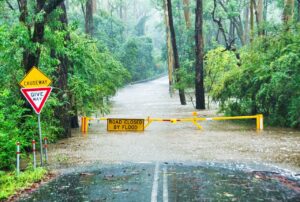Australia’s Great Flood
Australia’s Great Flood In 2010 / 2011
Understanding the scale and impact of Australia’s Great Flood, one of the most devastating natural disasters in history can be challenging. Occurring in 2011, this flood transformed metropolitan streets into turbulent rivers, causing extensive damage.
In this article, we will provide an in-depth look at this catastrophic event – beginning from its causes to its aftermath – helping you comprehend the magnitude and implications of such a disaster.
Get ready to embark on a journey that unveils nature’s wrath and humanity’s resilience.
Description of the Queensland Flood of 2011
The Queensland Flood of 2011 was a devastating natural disaster that affected the Australian state, causing widespread destruction and loss.
Scale of the flood
The scale of the 2011 Queensland flood surpassed all expectations. Its vast reach turned streets into rivers, covering entire towns under muddy waters and leaving cities isolated. However, its intensity didn’t stop at the city limits; rural areas were equally tormented as hectares of farmland disappeared beneath the rising tide.
As water levels rose to an unprecedented height, a freak inland tsunami added to the calamity, taking everyone by surprise. This event was more than just flooding; it was compared to a disaster of biblical proportions due to its extensive impact.
Overwhelming both urban and remote landscapes alike, this devastating event left over 25,000 homes and businesses ruined across Queensland and New South Wales combined.
Impact on towns and communities
The Queensland Flood of 2011 had a devastating impact on towns and communities in the region. The floodwaters transformed streets into rivers, causing widespread destruction of homes and infrastructure.
Over 20,000 homes and businesses were flooded in Queensland alone, while more than 5,000 homes were damaged in New South Wales. The floods not only resulted in significant property damage but also led to the displacement of thousands of residents who had to be evacuated for their safety.
This event highlighted the vulnerability of communities to extreme flooding and emphasized the need for improved disaster management strategies and preparedness measures.
Causes and Factors Contributing to the Flood
Heavy rainfall and weather patterns, river systems and infrastructure, as well as human activities and land management, played significant roles in the devastating flood in Queensland.
Heavy rainfall and weather patterns
The Queensland Flood of 2011 was triggered by heavy and prolonged rainfall combined with unique weather patterns. This extreme weather event dumped an unprecedented amount of rain across the region, leading to swollen rivers and flash flooding.
The intense rainfall saturated the ground, causing it to be unable to absorb any more water, exacerbating the flood conditions. Additionally, unusual weather patterns created a perfect storm for disaster as moisture from tropical cyclones contributed to the already high levels of precipitation.
These heavy rainfall and weather patterns played a crucial role in the severity and scale of Australia’s Great Flood.
River systems and infrastructure
The river systems and infrastructure in Queensland were severely impacted by the Great Flood of 2011. The heavy and prolonged rainfall caused rivers to overflow and flood their banks, overwhelming existing infrastructure designed to manage water flow.
Bridges were washed away, roads became impassable, and levees failed under the pressure of the rising waters. This led to widespread disruption of transportation networks, hindering emergency response efforts and evacuation measures.
The devastation highlighted the need for improved maintenance and resilience of river systems and infrastructure to better prepare for future flooding events.
Human activities and land management
Human activities and land management played a significant role in contributing to the devastating floods during Australia’s Great Flood event. Deforestation, urbanization, and poor land-use practices have all contributed to increased runoff and reduced natural water absorption.
These factors, coupled with improperly planned infrastructure such as dams and levees, resulted in heightened flood risk. The impact of human activities on river systems has also disrupted natural flow patterns, exacerbating flooding conditions.
Adequate land management practices and improved planning measures are crucial for preventing future flood disasters in Australia.
Devastation and Losses
The Queensland Flood of 2011 caused numerous fatalities, widespread damage to homes, infrastructure, and agriculture and had significant economic impacts.
Fatalities and injuries
The Great Flood in Australia resulted in numerous fatalities and injuries. Tragically, lives were lost as people were caught off guard by the suddenness and intensity of the floodwaters.
Emergency services worked tirelessly to rescue and provide assistance to those affected, but unfortunately, not everyone could be saved. In addition to the loss of life, many individuals sustained injuries during the evacuation process or from being exposed to hazardous conditions caused by flooding.
The toll on human lives was a devastating consequence of this natural disaster.
Damage to homes, infrastructure, and agriculture
The Great Flood in Australia caused extensive damage to homes, infrastructure, and agriculture. Thousands of homes and businesses were flooded in Queensland alone, while New South Wales experienced significant property damage as well.
The floodwaters transformed streets into rivers, leaving behind a trail of destruction. Bridges, roads, and other vital infrastructure were severely affected or washed away by the force of the floodwaters.
Additionally, farmland was submerged, causing immense losses for farmers and impacting the agricultural industry. The scale of the devastation serves as a stark reminder of the destructive power that floods can have on communities and essential systems.
Economic impacts
The economic impacts of Australia’s Great Flood were significant and far-reaching. The damage caused by the floods resulted in extensive financial losses for individuals, businesses, and the government.
In Queensland alone, it was estimated that the total economic cost of the floods exceeded $2 billion. This included expenses related to repairing damaged infrastructure, such as roads and bridges, as well as costs associated with rebuilding homes and businesses.
Additionally, many farmers suffered substantial crop losses and livestock deaths, leading to a decline in agricultural production. The flood event also had broader implications for the economy as a whole, including disruptions to transportation networks and a decrease in tourism revenue due to widespread destruction and safety concerns.
Response and Recovery Efforts
Emergency responders and rescue teams quickly mobilized to assist affected communities. Evacuation measures were implemented, ensuring the safety of residents. Rebuilding and rehabilitation efforts commenced immediately, focusing on restoring infrastructure and supporting affected individuals in their recovery journey.
The response to the great flood demonstrates the resilience of Australians in times of crisis. Read more about Australia’s determination to rebuild despite adversity.
Emergency response and rescue operations
Emergency response and rescue operations during Australia’s Great Flood were crucial in saving lives and providing assistance to affected communities.
- Emergency personnel and volunteers worked tirelessly to evacuate residents from flood-prone areas.
- Rescue teams utilized boats, helicopters, and other equipment to reach stranded individuals and bring them to safety.
- Temporary shelters were set up to provide refuge for those displaced by the floods.
- Medical teams were deployed to provide medical care, including treating injuries and addressing health concerns.
- Emergency services coordinated with local authorities to establish communication systems and provide timely updates on the situation.
- Relief organizations, such as the Australian Red Cross, played a vital role in distributing food, water, and essential supplies to those in need.
- Government agencies worked together to assess the extent of the damage and prioritize areas for assistance.
- Search and rescue efforts focused on locating missing persons and ensuring their well-being.
- Psychological support services were offered to help individuals cope with the trauma caused by the natural disaster.
Evacuation measures
Evacuation measures were crucial during Australia’s Great Flood in Queensland. They helped to ensure the safety and well-being of residents in affected areas.
- Activation of emergency warning systems to alert residents about the impending danger and the need to evacuate.
- Coordination of evacuation centers where people could seek shelter and assistance.
- Use of designated evacuation routes to ensure safe and organized movement away from flood-prone areas.
- Deployment of emergency personnel, including police, firefighters, and volunteers, to assist with evacuations and provide support to those in need.
- Evacuation of vulnerable populations, such as elderly individuals or those with medical conditions, prioritizing their safety and well-being.
- Establishment of communication channels with updates on evacuation procedures and instructions for residents in real time.
Rebuilding and rehabilitation
Rebuilding and rehabilitation after the Great Flood of 2011 was a massive undertaking. Here are some key initiatives that were undertaken to restore the affected areas:
- Extensive cleanup and removal of debris from streets, homes, and public spaces.
- Repairing damaged infrastructure such as roads, bridges, and electricity networks.
- Reconstructing houses and buildings that were destroyed or severely damaged.
- Providing financial assistance to affected individuals and businesses for rebuilding efforts.
- Implementing measures to mitigate future flood risks, such as improved drainage systems and levees.
- Enhancing emergency response capabilities to better handle future flood events.
- Promoting community resilience through educational programs and awareness campaigns.
- Engaging with experts in disaster management to learn from the experience and improve preparedness for similar events in the future.
Lessons Learned and Future Preparedness
Australia’s great flood serves as a necessary reminder of the importance of disaster management and preparedness. The catastrophic event highlights the need for improved infrastructure, consideration of climate change implications, and increased community resilience in order to mitigate future devastating floods.
Implications for disaster management
The Great Flood in Australia has significant implications for disaster management. The scale and devastation of the floods highlighted the need for improved preparedness and response strategies.
Emergency services must be equipped to handle extreme weather events, such as heavy rainfall and flooding, with efficient rescue operations and evacuation measures in place. Additionally, infrastructure improvements are crucial to mitigate future damage.
Climate change considerations should also be taken into account when developing disaster management plans, as extreme weather events may become more frequent and severe. Furthermore, building community resilience and preparedness through education and awareness programs is essential to ensure that individuals are well-prepared for potential disasters.
Infrastructure improvements
Infrastructure improvements following the Great Flood in Australia included:
- Repairing and strengthening bridges and roads that were damaged or destroyed by the floodwaters.
- Upgrading drainage systems to better handle future heavy rainfall events.
- Constructing flood levees and barriers to protect vulnerable areas from flooding.
- Implementing improved warning systems to notify communities of impending floods.
- Enhancing dam management strategies to more effectively control water levels during periods of heavy rainfall.
- Investing in research and development for innovative flood prevention technologies.
- Retrofitting buildings and structures to be more resilient against future flooding.
- Conducting assessments of critical infrastructure to identify vulnerabilities and prioritize necessary upgrades.
- Collaborating with experts in hydrology, engineering, and urban planning to develop long – term flood mitigation plans.
- Educating communities on flood risks, emergency preparedness, and response strategies.
Climate change considerations
Climate change considerations are an important aspect to address when discussing the Great Flood in Australia. The intense and prolonged rainfall that triggered the flood event is consistent with patterns associated with climate change.
Rising temperatures and changing weather patterns can lead to increased frequency and severity of extreme weather events, including heavy rainfall and flooding.
This highlights the need for proactive measures to mitigate the impacts of climate change, such as improving infrastructure resilience, implementing effective land management practices, and enhancing disaster preparedness efforts.
By taking these climate change considerations into account, we can better protect communities and minimize future devastation from floods in Australia.
The Great Flood also serves as a wake-up call regarding the long-term implications of climate change on flood risk in Australia. As sea levels continue to rise due to global warming, coastal regions will become more vulnerable to storm surges during extreme weather events.
Additionally, changes in precipitation patterns may result in more frequent droughts followed by heavy downpours, increasing the likelihood of flash floods. It is crucial for policymakers, urban planners, and communities to prioritize adaptation strategies that ensure sustainable development while reducing exposure to flood hazards.
Community resilience and preparedness
Communities play a crucial role in handling natural disasters like floods. During Australia’s Great Flood, community resilience and preparedness were key factors in managing the catastrophe.
Local residents banded together to support one another, providing assistance and shelter to those affected by the floods. Community organizations organized relief efforts, distributing food, water, and other necessities to people in need.
Additionally, communities worked hand-in-hand with emergency response teams to prioritize evacuation measures and ensure everyone’s safety. The ability of communities to come together during times of crisis demonstrated their resilience and readiness to face such challenges head-on.
Australia’s Great Flood (TV Movie 2012)
Australia’s Great Flood is also a television movie that was released in the year 2012. The film focuses on the real-life events of the historical Queensland floods in Australia, which occurred between December 2010 and January 2011.
This natural disaster resulted in extensive damage to homes, infrastructure and loss of lives across several regions in Australia.
Plot Summary
The movie captures the intense devastation caused by these floods through a series of compelling stories.
It portrays various individuals whose lives were profoundly affected by this calamity. The film highlights their struggles, resilience, and determination to survive amidst the chaos.
Main Characters
- Emma: A young woman who becomes separated from her family during the flood and must navigate her way through dangerous waters to find them.
- Jack: A brave firefighter dedicated to rescuing stranded residents trapped in their homes as the floodwaters rise.
- Kate: A local journalist reporting on scenes from ground zero provides viewers with an up-close perspective on the extent of destruction caused by flooding.
- Brian: An elderly man living alone whose house gets flooded, leaving him desperate for help before it’s too late.
Impact on Communities
This section sheds light on how different communities were severely impacted by these floods.
Towns were left underwater, leaving residents homeless and without access to basic necessities such as food and clean water. Schools and hospitals were also submerged or damaged beyond use.
Rescue Efforts
Here we see heroes emerge amidst this catastrophe as rescue teams work tirelessly around the clock to save lives. Helicopters are deployed to pluck victims from rooftops while boats navigate treacherous currents flooding streets-turned-rivers.
Emotional Toll
The film doesn’t shy away from portraying the emotional toll that such disasters have on individuals involved.
Families fear for their loved ones’ safety amidst communication breakdowns caused by downed power lines and structural collapses limiting accessibility.
Recovery and Rebuilding
The movie highlights the long and arduous process of recovery and rebuilding in the aftermath of such a devastating event.
Communities come together to support one another with relief efforts, housing assistance, volunteer work, and rehabilitation programs for those affected.
Conclusion
The Great Flood in Australia’s Queensland in 2011 was a devastating natural disaster of biblical proportions. It caused widespread destruction, including damage to homes, infrastructure, and agriculture.
The event served as a stark reminder of the future risks and implications of extreme flooding in Australia.
FAQs
1. When did Australia’s great flood occur?
Australia’s great flood occurred in early 2011.
2. What were the causes of Australia’s great flood?
Australia’s great flood was caused by heavy rainfall or a tropical cyclone.
3. How did the great flood affect people and infrastructure?
The great flood in Australia resulted in widespread damage to homes, buildings, roads, and bridges, displacing many people and disrupting daily life.
4. How is Australia preparing for future floods?
Australia is taking steps to better prepare for future floods by implementing improved forecasting systems, strengthening infrastructure resilience, and raising awareness about emergency preparedness measures among communities.




